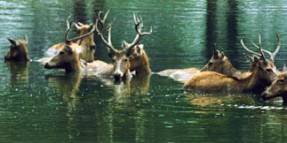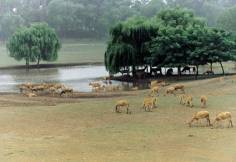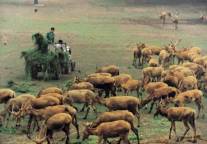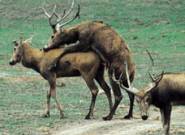 设为首页
设为首页
 加入收藏
加入收藏
The Dafen Nature Reserve for Milu Deer (another name: David’s Deer) in Jiangsu Province is known as the first open breeding base of Milu Deer in the world. After ten year’s hard work, the ecological environment of the nature reserve has been gratly improved and the number of Milu Deer has risen from 39 to 268. The ecological tour with a theme of protecting the deer and the nature has attracted many visitors from home and abroad.
Milu Deer, a rare animal species in China, can weigh about 250kg.Thanks to open breeding, the deer can grow healthily with all its natural attributes.
The group of Milu Deer has multiplied over the past ten years, most of them restoring the habits and characteristics of wild animals.
Significance of wildlife protection
With rapid loss of many wild animals and plants, more and more people come to realize the great importance of wildlife protection.
We have to understand the problem in a new light that we protect ourselves through protecting wildlife . On one hand, any kind of wildlife, as a important joint of the natural chain, helps to keep the natural balance. If one kind dies out, it will disappear forever. What is more, it will result in the loss of a chain of wildlife and the trouble of the natural balance. Unpredictable disasters may occur. On the other hand, with the development of modem science and technology, man is just beginning to learn wildlife. For example, if wild rubber trees had died out two centuries ago, there would be no auto industry today.
It is very important for us to protect wildlife right now before it is too late, because man has already polluted the environment seriously and endangered the life of many wild species. Lei s take action to protect wildlife. Learning to live in harmony with all wildlife is part of modern civilization.
Dafeng Milu nature Park lies in the southeast of Dafeng County, and covers 15,000 mu. It is not only one of the largest centres for milu deer’s horns, neck, feet and tail are respectively similar to a deer s, a camel s, an ox s and a donkey s, it is often called Sibuxiang. It disappeared in natured for thousands of years because of the changing of environment and the human s activities. It had been fed up only in the Emperors parks since the Song period. And even those deer disappeared during the Ming and the Qing periods. In 1985 Dafeng Milu Deer Centre was set up in Jiangsu Province. The first 39 milu deer, coming from London Zoo in Britain, were looked after here. Now there are more than 200 milu dear in this centre.
 David's Deer Comes Home
David's Deer Comes HomeTHE milu (David's deer), an animal formerly unique to China, is commonly called "sibuxiang" (unlike any of the four) by Chinese people, because of its horse's head, donkey's tail, ox hooves and deer antlers. On the inception of ancient Chinese characters, the pictographic "mi" was one of the first to be engraved on tortoise-shell and animal bones. Later, throughout various dynasties, the animal was bred in imperial parks but, tragically, by 1900 it had become extinct in China. After 100 years separation from its motherland, the David's deer has now returned.
A Fascinating Saga
During the past two million years, the David's deer has evolved at roughly the same pace as humankind, yet it only became known to biologists in 1865, during the fourth year of the reign of Qing Dynasty Emperor Tongzhi. Pere Armand David, a French zoologist and missionary, was carrying out research in the southern outskirts of Beijing at that time. A casual glimpse over the fence of the imperial park astonished him: there stalked a herd of the strangest looking animals he could ever imagine. What perplexed him still further was the fact that they could be found nowhere but in the imperial park.
The David's deer had long been the symbol of imperial power in China. Having been bred in captivity, the species survived, but its siblings in the wild rapidly became extinct.
 Related to a species of wild wetland cattle,
the David's deer originally lived along
the banks of the Yangtze and Yellow
rivers of China. It grazed on grass,
and was a sturdy, sprightly animal.
Bucks' horns sprouted in spring and
were shed in autumn, in line with nature's
cycle, but Chinese ancients interpreted
this phenomenon as a sign from heaven,
and regarded the David's deer as an
auspicious animal. Emperors believed
that imperial authority was God's will
and wanted their power to be passed
on forever within their dynasty, in
the same way as the horns of the David's
deer would continue to be discarded
and replaced. The emperors would therefore
hold grand ceremonies outdoors every
autumn, to observe the spectacle of
David's deer shedding their horns.
Related to a species of wild wetland cattle,
the David's deer originally lived along
the banks of the Yangtze and Yellow
rivers of China. It grazed on grass,
and was a sturdy, sprightly animal.
Bucks' horns sprouted in spring and
were shed in autumn, in line with nature's
cycle, but Chinese ancients interpreted
this phenomenon as a sign from heaven,
and regarded the David's deer as an
auspicious animal. Emperors believed
that imperial authority was God's will
and wanted their power to be passed
on forever within their dynasty, in
the same way as the horns of the David's
deer would continue to be discarded
and replaced. The emperors would therefore
hold grand ceremonies outdoors every
autumn, to observe the spectacle of
David's deer shedding their horns.
King Wen of the Western Zhou Dynasty (around the 11th century B.C.) established sacred deer breeding parks along riverbanks to preserve the David's deer. King Xuan (who reigned around 319 B.C.-301B.C.) of the State of Qi went so far as to promulgate a decree, stating that those caught hunting David's deer would be punished as murderers. Succeeding dynasties kept up the tradition of breeding this animal in imperial parks, until the David's deer won the honor of becoming synonymous with the emperor's throne. However, the wild species could not escape relentless hunting, which occurred simultaneously with the drive to reclaim land from lakes along the Yangtze River, and it became extinct between the 14th and 17th centuries of the Ming Dynasty.
 David's discovery of this rare animal in
the imperial park so fascinated him,
he lingered on in Beijing for months.
Eventually, by bribing a warden with
20 taels of silver, he obtained the
hide and skeleton of one animal which
he sent to Paris. After close examination,
French zoologists announced the discovery
of a new genus of deer, and named it
David's deer.
David's discovery of this rare animal in
the imperial park so fascinated him,
he lingered on in Beijing for months.
Eventually, by bribing a warden with
20 taels of silver, he obtained the
hide and skeleton of one animal which
he sent to Paris. After close examination,
French zoologists announced the discovery
of a new genus of deer, and named it
David's deer.
This new discovery created a great sensation in Europe. However, in China, the ineffectual Qing Dynasty could barely sustain its own sovereignty, let alone the survival of a deer species. Consequently, when the Eight-Power Allied Forces captured Beijing, they looted the imperial park, and the milu disappeared from China.
Being unaccustomed to the European climate, many of the David's deer died after their migration, until the 11th Duke of Bedford, a dedicated animal-lover, came to the rescue. He bought 18 head of David's deer from various countries at enormous expense, and kept them in Woburn Abbey Manor, where fresh water and lush grass were abundant. The animals were thus saved from extinction, and their total number had risen to 255 by World War II.
Welcome Home
 On August 24, 1985, as a token of Sino-British
friendship, 22 head of David's deer
were flown to Beijing from the U.K.
"It means a lot to my family and
me to send the David's deer home,"
said the owner of Woburn Abbey. This
was one of three "re-introduction"
projects carried out by the Species
Protection Commission of the World Nature
Protection Alliance. The aim of these
projects is to re-introduce formerly
extinct species to their places of origin,
and to let them breed and live once
more in their natural communities.
On August 24, 1985, as a token of Sino-British
friendship, 22 head of David's deer
were flown to Beijing from the U.K.
"It means a lot to my family and
me to send the David's deer home,"
said the owner of Woburn Abbey. This
was one of three "re-introduction"
projects carried out by the Species
Protection Commission of the World Nature
Protection Alliance. The aim of these
projects is to re-introduce formerly
extinct species to their places of origin,
and to let them breed and live once
more in their natural communities.
With ample water, dense forest and lush grassland, Nanhaizi in the southern outskirts of Beijing is where the imperial park was located during the Qing Dynasty. Upon their return, the animals soon readjusted, and now lead a happy and safe life in their ancestral home.
The
summer of 1986 signaled commencement
of the animal rutting season, when,
after fierce battling among bucks, the
victors established their herds and
fulfilled their sacred duty
of continuing the family line.
In May 1986 dams sought out tranquil places to give birth. The birth usually takes about three hours, and any disturbance could be disastrous. Humans are strictly forbidden in the area as any strange scent would make the mother take fright and abandon her fawn. As a means to producing still more milk, the dam eats the afterbirth and placenta after giving birth, then licks clean her offspring. A few hours later the mother hides her fawn and returns to the herd. She then feeds the young deer daily until it is strong enough to live within the herd.
Since November 1993, the Nanhaizi Park has transported the David's deer to the Swan Islet nature reserve in Shishou by the Yangtze River. Since then, a natural community has evolved, which successfully withstood the huge 1998 flooding of the Yangtze River. Some escaped by swimming and scrambling to higher altitudes, and surviving on crops they found there. The rest converged on the islet, living on forage shipped in by staff members and local villagers. There are now approximately 800 head of David's deer in China, and it is no longer one of the world's endangered species.
David's Deer Leads the Way
 As regards its relationship with nature,
the David's deer has done even better
than humankind. In adapting itself to
nature, the animal evolved into a form
strikingly different from other deer.
Its broad hooves enable it to tread
firmly on marshland; its long tail helps
it flick away the inevitable swarms
of mosquitoes found in wetlands; it
is impossible for its backward pointing
horn-forks to get stuck in mud; and
the lofty posture of its horse head
ensures it can swim with a lesser risk
of drowning than other species.
As regards its relationship with nature,
the David's deer has done even better
than humankind. In adapting itself to
nature, the animal evolved into a form
strikingly different from other deer.
Its broad hooves enable it to tread
firmly on marshland; its long tail helps
it flick away the inevitable swarms
of mosquitoes found in wetlands; it
is impossible for its backward pointing
horn-forks to get stuck in mud; and
the lofty posture of its horse head
ensures it can swim with a lesser risk
of drowning than other species.
In Chinese the name of David's deer has the same pronunciation as that meaning "losing the way." However, it is human beings who have really lost their way. A look back at history shows that the tens of thousands of years of civilization achieved by man has been at the cost of our natural environment. The wetlands, a haven for David's deer, have been dubbed the kidneys of the world, but centuries of devastation have led to serious soil erosion, depriving wetland animals of their natural habitat and the environment of one of its vital functions. The return of David's deer to China is a reminder to the Chinese people of the imperative need to protect our mother earth.
 The project in Nanhaizi also serves as
an environmental education base for
Chinese youth. A cemetery has been erected
for extinct animals, in which stands
a giant cross engraved with the names
of species that have died out. On the
Pure Brightness Festival of April 5,
2000, a group of blind children came
to sweep the grave of these animals.
Moving his fingertips over his Braille
speech, one boy stated, "Humans
should not be rulers of the earth, but
a part of nature. Please remember: more
space for animals means more space for
ourselves."
The project in Nanhaizi also serves as
an environmental education base for
Chinese youth. A cemetery has been erected
for extinct animals, in which stands
a giant cross engraved with the names
of species that have died out. On the
Pure Brightness Festival of April 5,
2000, a group of blind children came
to sweep the grave of these animals.
Moving his fingertips over his Braille
speech, one boy stated, "Humans
should not be rulers of the earth, but
a part of nature. Please remember: more
space for animals means more space for
ourselves."